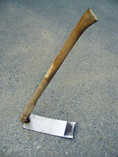Metal Weapons
![]()
![]() There are only two total metal weapons that are used by the students, and these are the Sai and the Manji Sai. All the rest are a combination of wood and metal. With the mixed material weapons then both instruction of care of wooden and metal weapons apply.
There are only two total metal weapons that are used by the students, and these are the Sai and the Manji Sai. All the rest are a combination of wood and metal. With the mixed material weapons then both instruction of care of wooden and metal weapons apply.
Metal and those that are of mixed make consist of:
- Sai
- Nunti Bo
- Kama
- Timbe
- Kuwa
- Manji Sai
Buying these Weapons
 Once again always check the weapon for damage before purchase. Nicks in blades, damaged, warped, unravelled handles. Check the size and design of the weapon is correct. It may be round, hexagonal, octagonal, chrome, stainless steel or natural. Make sure all parts are attached securely. Make sure that the weapon is the correct size for you. If you're unsure get advice from your Sensei first.
Once again always check the weapon for damage before purchase. Nicks in blades, damaged, warped, unravelled handles. Check the size and design of the weapon is correct. It may be round, hexagonal, octagonal, chrome, stainless steel or natural. Make sure all parts are attached securely. Make sure that the weapon is the correct size for you. If you're unsure get advice from your Sensei first.
Preparing Weapons
 Little in preparation should be needed. With those weapons that have handles or shafts, such as Kama, Nunti and Kuwa etc. the wooden shaft should be treated as with wooden weapons. A very light coat of clove or vegetable oil, or equivalent, may be applied to metal blades. Do not get any oil on handles or shafts.
Little in preparation should be needed. With those weapons that have handles or shafts, such as Kama, Nunti and Kuwa etc. the wooden shaft should be treated as with wooden weapons. A very light coat of clove or vegetable oil, or equivalent, may be applied to metal blades. Do not get any oil on handles or shafts.
Maintenance
Again each weapon should have it's own carry case. This will keep it clean and protect it from nicks and knocks. It will also stop it from damaging any other weapons. The grip on the Sai will require maintenance periodically. You may also customise with your own grips. Special leather or cord may be used to replace the standard covering. Remember how the grip was removed so that you can replace it correctly. Check the blades of the weapon for damage, before and after training. Make sure that the blade is firmly attached to the shaft. If the weapon is damaged do not use it.


